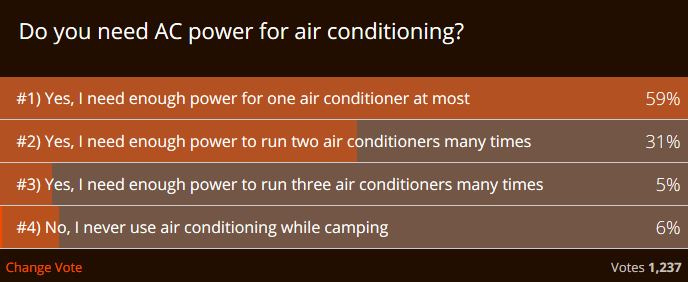Dear Readers,
I fully expect this will stir up a little controversy since the idea of unmetered (“free”) electric power at campgrounds has been the standard for a long time. But there is a campground industry push to meter each pedestal separately and charge you for it in some way.
The reasons for wanting to do individual pedestal metering have been growing for the last few decades. Ever since multiple rooftop air conditioners have become more common, campground power usage has gone way up. Here are the results of a survey I took back in July of 2020.
Do you need AC power for air conditioning? (Survey from July 2020)
Yes, RVs need more power than ever
Well, I sort of guessed this, but it’s good to see the numbers. So nearly 2/3 of you need power for one air conditioner, while nearly 1/3 of you need enough power for two air conditioners, and 5% need power for three air conditioners. This is exactly why so many campgrounds are struggling to keep up with the power requirements. When many of them were designed and built 20 years or more ago, nobody could guess at just how many campers would need so much electricity to power their RVs. Just like in the ’60s and ’70s, when most cars didn’t have air conditioning and power steering, it’s nearly impossible buy a new vehicle now without these as included options. More to study about campground power, which I’m working on.
There’s even more power needed
Now lets add in all the new lithium battery chargers which can easily draw 10 amps at 120 volts, electric water heaters that can draw another 10 to 12.5 amps at 120 volts (1,200 to 1,500 watts), and families who are now using electric cooking appliances such as 1,500-watt air fryers (12.5 amps at 120 volts).
It’s no wonder that 30-amp shore power plugs are melting down and many RV owners are demanding 50-amp/240-volt (actually 100 amps at 120 volts) pedestal outlets.
What about EV charging?
Yes, you can buy your own Class-2 charger for your EV truck or toad, which can require 40-amps at 240-volts for 10 hours or so to recharge its 100 kWh batteries. However, this will cost the average campground at least $17 (and probably more) per EV in extra electricity cost (at 17.1 cents per kWh 2023 business average in the USA).
Here are the numbers!
An EV with a 100kWh battery can take 10 hours at 40 amps and 240 volts with a Level-2 charge to recharge completely. Since 100kWh (kilowatt hours) times 17.1 cents per kWh equals $17.10, that’s probably $18 for a full charge, adding in a little for efficiency losses.
That’s in addition to whatever other power you’re using for air conditioners and electric appliances. Plus, electric space heaters are just as power hungry. And I’m not even counting the latest RV trailers such as the Airstream E-Stream with built-in traction motors and 75 kWh batteries that will help push the EV down the road! Many campgrounds report that their monthly electric bills are tens of thousands of dollars. Yikes!
Is this why campground power is so poor?
Yes, I think that’s a large part of it. Campground owners consider electricity bills to be a loss leader (again, they can pay tens of thousands of dollars per month). So there’s no incentive for them to upgrade power or even maintain the pedestals.
And be aware that to upgrade even a medium-size campground with modern wiring and pedestals that’s capable of supplying all the power you demand without voltage drop, can cost upwards of $500,000, even with volunteer labor to help dig the trenches. And have you seen the price of copper wire lately? It’s more than doubled in the last two years.
Can campgrounds really automate electricity billing?
They most certainly can. There’s a number of companies making smart pedestals that can turn the power on and off at specific times, and that will automatically charge your credit card on file.
Just like your electric bill at home, if you use more, you pay more; and if you use less, you pay less. Here’s the quote from Wild Energy about their latest smart pedestals. Of course, this is being pitched to campground owners about investing in Smartposts, not the end consumer who has the pay the bill. Read more HERE.
“We have patented technology to convert power pedestals into “Smartposts” which can be controlled, monitored, and metered remotely. Easy to install with a great return on investment. Transient / overnight, and long term seasonal options. Fully Automated Parks? Yep, we can do that too!”
Will metering pedestals force campgrounds to provide better power?
I would hope so, but I’m not Carnac the Magnificent. I can only show my equations and report the numbers I calculate. After that it’s up to market forces and the cost of electricity to drive this trend. But I do believe it’s going to happen sooner rather than later, especially for new campgrounds being built.
So please take this survey and add any (polite) comments below. Yes, we all hate the extra costs, but if you want to dance you need to pay the fiddler.
Let’s play safe out there… Mike











How would you all like to participate in a Town Hall webcast with Tony Barthel and myself on this topic? It would stream over YouTube Live as well as a few Facebook groups. And I guarantee that a lot of campground owners will be watching as well.
My 25’ RV has 300Ah of lithium batteries and 520W of solar. Unless air conditioning is needed, I don’t require camp ground power. Let’s each pay for what we use. If the big boys want to charge an EV and run 3 AC’s, by all means go right ahead. I prefer to pay for my space separate from my power bill.